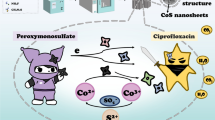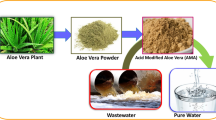Abstract
The extremely acidophilic, Fe(III)-reducing heterotrophic bacterium Acidocella aromatica strain PFBC was tested for its potential utility in bioreduction of highly toxic heavy metal, hexavalent chromium, Cr(VI). During its aerobic growth on fructose at pH 2.5, 20 µM Cr(VI) was readily reduced to Cr(III), achieving the final Cr(VI) concentration of 0.4 µM (0.02 mg/L), meeting the WHO drinking water guideline of 0.05 mg/L. Despite of the highly inhibitory effect of Cr(VI) on cell growth at higher concentrations, especially at low pH, Cr(VI) reduction activity was readily observed in growth-decoupled cell suspensions under micro-aerobic and anaerobic conditions. Strain PFBC was not capable of anaerobic growth via dissimilatory reduction of Cr(VI), such as reported for Fe(III). In the presence of both Cr(VI) and Fe(III) under micro-aerobic condition, microbial Fe(III) reduction occurred only upon complete disappearance of Cr(VI) by its reduction to Cr(III). Following Cr(VI) reduction, the resultant Cr(III), supposedly present in the form of cationic CrIII(OH2) 3+6 , was partially immobilized on the negatively charged cell surface through biosorption. When Cr(III) was externally provided, rather than microbially produced, it was poorly immobilized on the cell surface. Cr(VI) reducing ability was reported for the first time in Acidocella sp. in this study, and its potential role in biogeochemical cycling of Cr, as well as its possible utility in Cr(VI) bioremediation, in highly acidic environments/solutions, were discussed.







Similar content being viewed by others
References
Allegretti P, Furlong J, Donati E (2006) The role of higher polythionates in the reduction of chromium(VI) by Acidithiobacillus and Thiobacillus cultures. J Biotechnol 122:55–61
Barrera-Díaz CE, Lugo-Lugo V, Bilyeu B (2012) A review of chemical, electrochemical and biological methods for aqueous Cr(VI) reduction. J Hazard Mater 223:1–12
Belchik SM, Kennedy DW, Dohnalkova AC, Wang YM, Sevinc PC, Wu H, Lin YH, Lu HP, Fredrickson JK, Shi L (2011) Extracellular reduction of hexavalent chromium by cytochromes MtrC and OmcA of Shewanella oneidensis MR-1. Appl Environ Microbiol 77:4035–4041
Bencheikh-Latmani R, Obraztsova A, Mackey MR, Ellisman MH, Tebo BM (2007) Toxicity of Cr(III) to Shewanella sp. strain MR-4 during Cr(VI) reduction. Environ Sci Technol 41:214–220
Camargo FAO, Okeke BC, Bento FM, Frankenberger WT (2003) In vitro reduction of hexavalent chromium by a cell-free extract of Bacillus sp. ES 29 stimulated by Cu2+. Appl Microbiol Biotechnol 62:569–573
Chai LY, Huang SH, Yang ZH, Peng B, Huang Y, Chen YH (2009) Hexavalent chromium reduction by Pannonibacter phragmitetus BB isolated from soil under chromium-containing slag heap. J Environ Sci Health Part A 44:615–622
Chardin B, Dolla A, Chaspoul F, Fardeau ML, Gallice P, Bruschi M (2002) Bioremediation of chromate: thermodynamic analysis of the effects of Cr(VI) on sulfate-reducing bacteria. Appl Microbiol Biotechnol 60:352–360
Chovanec P, Sparacino-Watkins C, Zhang N, Basu P, Stolz JF (2012) Microbial reduction of chromate in the presence of nitrate by three nitrate respiring organisms. Front Microbiol 3:1–12
Cornelis R, Caruso JA, Crews H, Heumann KG (2005) Handbook of elemental speciation II: species in the environment, food, medicine and occupational health. Wiley, Chichester
Coupland K, Johnson DB (2008) Evidence that the potential for dissimilatory ferric iron reduction is widespread among acidophilic heterotrophic bacteria. FEMS Microbiol Lett 279:30–35
Cummings DE, Fendorf S, Singh N, Sani RK, Peyton BM, Magnuson TS (2007) Reduction of Cr(VI) under acidic conditions by the facultative Fe(III)-reducing bacterium Acidiphilium cryptum. Environ Sci Technol 41:146–152
Dey S, Paul AK (2010) Occurrence and evaluation of chromium reducing bacteria in seepage water from chromite mine quarries of Orissa, India. J Water Resource Prot 2:380–388
Dhal B, Thatoi HN, Das NN, Pandey BD (2013) Chemical and microbial remediation of hexavalent chromium from contaminated soil and mining/metallurgical solid waste: a review. J Hazard Mater 250:272–291
Elangovan R, Philip L, Chandraraj K (2010) Hexavalent chromium reduction by free and immobilized cell-free extract of Arthrobacter rhombi-RE. Appl Biochem Biotechnol 160:81–97
Fendorf SE, Li GC (1996) Kinetics of chromate reduction by ferrous iron. Environ Sci Technol 30:1614–1617
Francis CA, Obraztsova AY, Tebo BM (2000) Dissimilatory metal reduction by the facultative anaerobe Pantoea agglomerans SP1. Appl Environ Microbiol 66:543–548
Fredrickson JK, Kostandarithes HM, Li SW, Plymale AE, Daly MJ (2000) Reduction of Fe(III), Cr(VI), U(VI), and Tc(VII) by Deinococcus radiodurans R1. Appl Environ Microbiol 66:2006–2011
García S, Ciullo L, Olivera MS, Gonzalez JC, Bellu S, Rockembauer A, Korecz L, Sala LF (2006) Kinetics and mechanism of the reduction of chromium(VI) by d-fructose. Polyhedron 25:1483–1490
Guha H, Jayachandran K, Maurrasse F (2003) Microbiological reduction of chromium(VI) in presence of pyrolusite-coated sand by Shewanella alga Simidu ATCC 55627 in laboratory column experiments. Chemosphere 52:175–183
Hawley EL, Deep RA, Kavanaugh MC, Jacobs JA (2005) Treatment technologies for chromium(VI). In: Guertin J, Jacobs JA, Avakian CP (eds) Chromium(VI) handbook. CRC Press, Boca Raton, pp 275–310
He ZG, Gao FL, Sha T, Hu YH, He C (2009) Isolation and characterization of a Cr(VI)-reduction Ochrobactrum sp. strain CSCr-3 from chromium landfill. J Hazard Mater 163:869–873
He MY, Li XY, Liu HL, Miller SJ, Wang GJ, Rensing C (2011) Characterization and genomic analysis of a highly chromate resistant and reducing bacterial strain Lysinibacillus fusiformis ZC1. J Hazard Mater 185:682–688
Ibrahim ASS, El-Tayeb MA, Elbadawi YB, Al-Salamah AA, Antranikian G (2012) Hexavalent chromate reduction by alkaliphilic Amphibacillus sp. KSUCr3 is mediated by copper-dependent membrane-associated Cr(VI) reductase. Extremophiles 16:659–668
Ishibashi Y, Cervantes C, Silver S (1990) Chromium reduction in Pseudomonas putida. Appl Environ Microbiol 56:2268–2270
Jacobs JA, Testa SM (2005) Overview of chromium(VI) in the environment: background and history. In: Guertin J, Jacobs JA, Avakian CP (eds) Chromium(VI) handbook. CRC Press, Boca Raton, pp 275–310
Johnson DB, McGinness S (1991) Ferric iron reduction by acidophilic heterotrophic bacteria. Appl Environ Microbiol 57:207–211
Jones RM, Hedrich S, Johnson DB (2013) Acidocella aromatica sp nov.: an acidophilic heterotrophic alphaproteobacterium with unusual phenotypic traits. Extremophiles 17:841–850
Joutey NT, Bahafid W, Sayel H, Ananou S, Ghachtouli NE (2014) Hexavalent chromium removal by a novel Serratia proteamaculans isolated from the bank of Sebou River (Morocco). Environ Sci Pollut Res 21:3060–3072
Leita L, Margon A, Sinicco T, Mondini C (2011) Glucose promotes the reduction of hexavalent chromium in soil. Geoderma 164:122–127
Lovley DR, Phillips EJP (1994) Reduction of chromate by Desulfovibrio vulgaris and its c 3 cytochrome. Appl Environ Microbiol 60:726–728
Magnuson TS, Swenson MW, Paszczynski AJ, Deobald LA, Kerk D, Cummings DE (2010) Proteogenomic and functional analysis of chromate reduction in Acidiphilium cryptum JF-5, an Fe(III)-respiring acidophile. Biometals 23:1129–1138
Mangaiyarkarasi MSM, Vincent S, Janarthanan S, Rao TS, Tata BVR (2011) Bioreduction of Cr(VI) by alkaliphilic Bacillus subtilis and interaction of the membrane groups. Saudi J Biol Sci 18:157–167
Mclean JS, Beveridge TJ, Phipps D (2000) Isolation and characterization of a chromium-reducing bacterium from a chromated copper arsenate-contaminated site. Environ Microbiol 2:611–619
Megharaj M, Avudainayagam S, Naidu R (2003) Toxicity of hexavalent chromium and its reduction by bacteria isolated from soil contaminated with tannery waste. Curr Microbiol 47:51–54
Michel C, Brugna M, Aubert C, Bernadac A, Bruschi M (2001) Enzymatic reduction of chromate: comparative studies using sulfate reducing bacteria—key role of polyheme cytochromes c and hydrogenases. Appl Microbiol Biotechnol 55:95–100
Noroozifar M, Khorasani-Motlagh M (2003) Specific extraction of chromium as tetrabutylammonium-chromate and spectrophotometric determination by diphenylcarbazide: speciation of chromium in effluent streams. Anal Sci 19:705–708
Opperman DJ, van Heerden E (2007) Aerobic Cr(VI) reduction by Thermus scotoductus strain SA-01. J Appl Microbiol 103:1907–1913
Park CH, Keyhan M, Wielinga B, Fendorf S, Matin A (2000) Purification to homogeneity and characterization of a novel Pseudomonas putida chromate reductase. Appl Environ Microbiol 66:1788–1795
Patra RC, MalikS Beer M, Megharaj M, Naidu R (2010) Molecular characterization of chromium(VI) reducing potential in gram positive bacteria isolated from contaminated sites. Soi Biol Biochem 42:1857–1863
Puzon GJ, Roberts AG, Kramer DM, Xun LY (2005) Formation of soluble organo-chromium(III) complexes after chromate reduction in the presence of cellular organics. Environ Sci Technol 39:2811–2817
QuiIntana A, Curutchet G, Donati E (2001) Factors affecting chromium(VI) reduction by Thiobacillus ferrooxidans. Biochem Eng J 9:11–15
Rai D, Eary LE, Zachara JM (1989) Environmental chemistry of chromium. Sci Total Environ 86:15–23
Sarangi A, Krishnan C (2008) Comparison of in vitro Cr(VI) reduction by CFEs of chromate resistant bacteria isolated from chromate contaminated soil. Bioresour Technol 99:4130–4137
Shen H, Wang YT (1993) Characterization of enzymatic reduction of hexavalent chromium by Escherichia coli Atcc-33456. Appl Environ Microbiol 59:3771–3777
Sisti F, Allegretti P, Donati E (1996) Reduction of dichromate by Thiobacillus ferrooxidans. Biotechnol Lett 18:1477–1480
Soni SK, Singh R, Awasthi A, Singh M, Kalra A (2013) In vitro Cr(VI) reduction by cell-free extracts of chromate-reducing bacteria isolated from tannery effluent irrigated soil. Environ Sci Pollut Res 20:1661–1674
Sparks DL (2002) Environmental soil chemistry, 2nd edn. Academic Press, San Diego
Tandon RK, Crisp PT, Ellis J, Baker RS (1984) Effect of pH on chromium(VI) species in solution. Talanta 31:227–228
Tebo BM, Obraztsova AY (1998) Sulfate-reducing bacterium grows with Cr(VI), U(VI), Mn(IV), and Fe(III) as electron acceptors. FEMS Microbiol Lett 162:193–198
Viamajala S, Peyton BM, Apel WA, Petersen JN (2002) Chromate reduction in Shewanella oneidensis MR-1 is an inducible process associated with anaerobic growth. Biotechnol Progr 18:290–295
Wang PC, Mori T, Komori K, Sasatsu M, Toda K, Ohtake H (1989) Isolation and characterization of an Enterobacter cloacae strain that reduces hexavalent chromium under anaerobic conditions. Appl Environ Microbiol 55:1665–1669
Wielinga B, Mizuba MM, Hansel CM, Fendorf S (2001) Iron promoted reduction of chromate by dissimilatory iron-deducing bacteria. Environ Sci Technol 35:522–527
Xu L, Luo MF, Jiang CY, Wei XT, Kong P, Liang XF, Zhao JM, Yang LR, Liu HZ (2012) In vitro reduction of hexavalent chromium by cytoplasmic fractions of Pannonibacter phragmitetus LSSE-09 under aerobic and anaerobic conditions. Appl Biochem Biotechnol 166:933–941
Zakaria ZA, Zakaria Z, Surif S, Ahmad WA (2007) Hexavalent chromium reduction by Acinetobacter haemolyticus isolated from heavy-metal contaminated wastewater. J Hazard Mater 146:30–38
Zhu WJ, Chai LY, Ma ZM, Wang YY, Mao HJ, Zhao K (2008) Anaerobic reduction of hexavalent chromium by bacterial cells of Achromobacter sp. strain Ch1. Microbiol Res 163:616–623
Acknowledgments
This work was partly supported by grants from the Japan Society for the Promotion of Science (JSPS: No. 23810024), Kurita Water and Environment Foundation (KWEF: No. 23001), and the Kyushu University P and P program. The XAFS experiments were performed at Kyushu University Beamline (SAGA-LS/BL06: No. 2013IIK018). Y. Masaki is grateful for financial assistance provided by the Kyushu University Advanced Graduate Program in Global Strategy for Green Asia. Ac. aromatica PFBC was kindly provided by Prof. D. B. Johnson (University of Bangor, UK).
Author information
Authors and Affiliations
Corresponding author
Additional information
Communicated by A. Oren.
Rights and permissions
About this article
Cite this article
Masaki, Y., Hirajima, T., Sasaki, K. et al. Bioreduction and immobilization of hexavalent chromium by the extremely acidophilic Fe(III)-reducing bacterium Acidocella aromatica strain PFBC. Extremophiles 19, 495–503 (2015). https://doi.org/10.1007/s00792-015-0733-6
Received:
Accepted:
Published:
Issue Date:
DOI: https://doi.org/10.1007/s00792-015-0733-6




